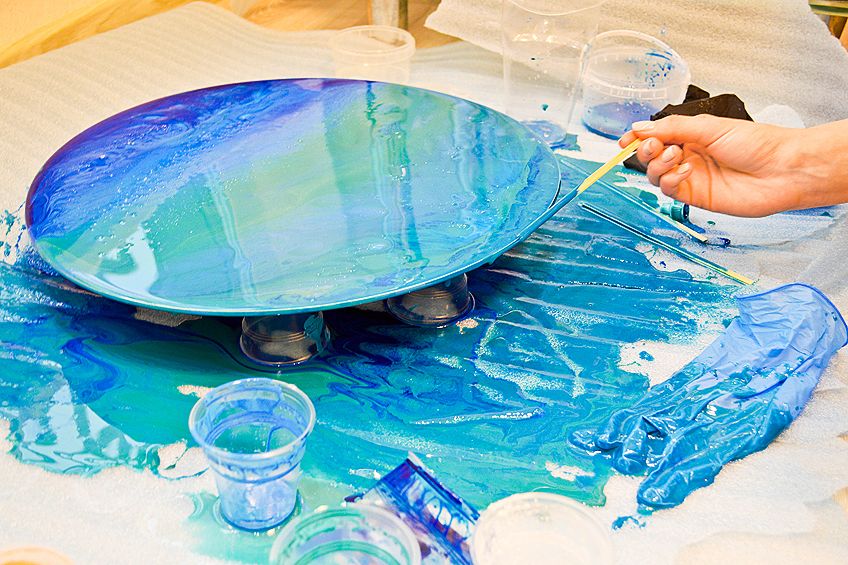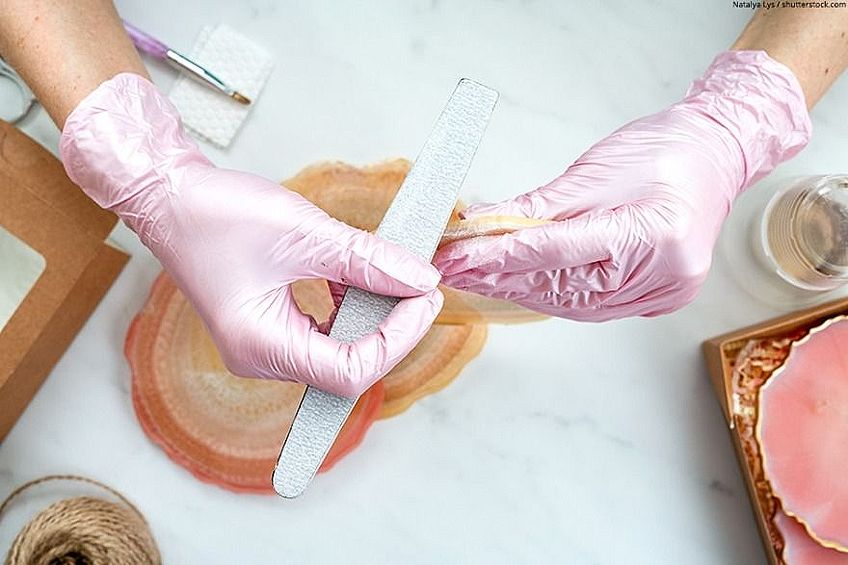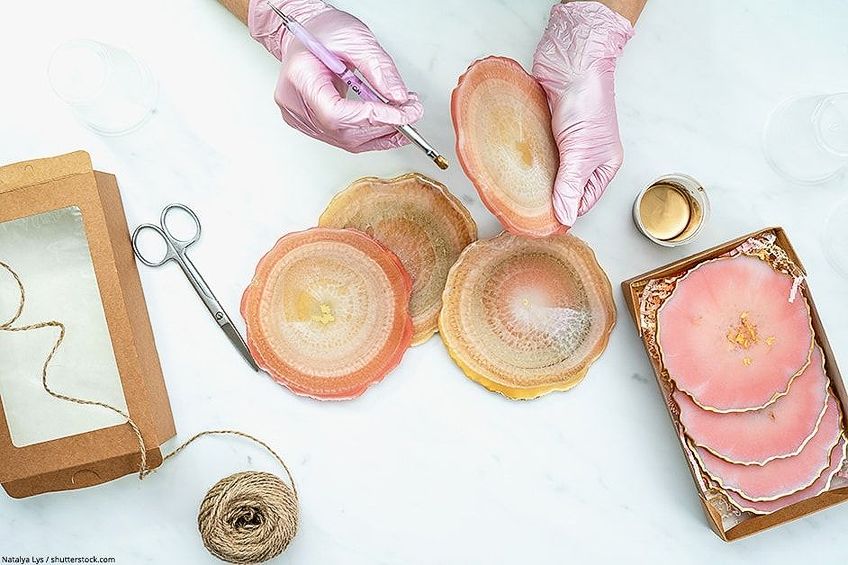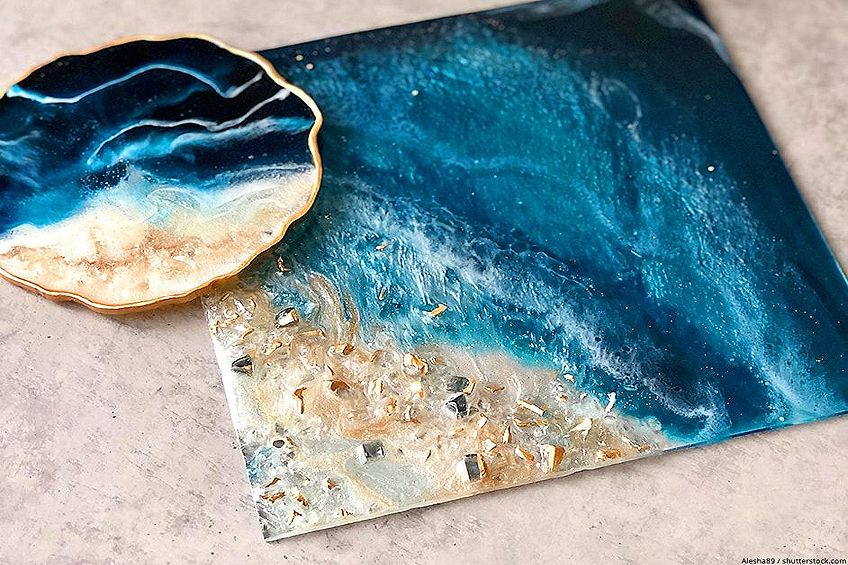What Kind of Paint to Use on Resin
This postal service may incorporate affiliate links. We may earn a small commission from purchases fabricated through them, at no additional price to you.
Epoxy resin is very dissimilar to canvas when it comes to painting. A resin surface is much smoother than that of canvass, which can prevent the pigment from adhering fully. In this article, we will lead you through the nuts of painting on resin and requite you our top tips and tricks to help y'all achieve the perfect finish.
Table of Contents
- ane Painting on Resin
- 2 Pace-by-Step Guide to Painting on Resin
- two.1 Step One: Clean Your Surface Properly
- 2.2 Step Ii: Sanding Down Your Resin Surface
- 2.3 Pace Three: Fill up Any Holes
- two.four Step Four: Always Utilise a Primer
- two.5 Pace 5: Time to Pigment
- ii.6 Step Vi: Seal Information technology All Up
- 3 How to Paint Resin Models
- 4 Our Top Tips and Tricks for Painting Resin
- 4.1 Choosing the Right Paintbrush for Resin Painting
- 4.two Patience is Central
- 4.iii Apply Primers and Varnishes with Caution
- 4.4 Painting Between Layers of Resin
- iv.five Paint on Resin is Fairly Forgiving
- 4.half-dozen Try Playing with Empty Infinite
- 5 Frequently Asked Questions
- 5.i What Kind of Paint Will Stick to Epoxy?
- 5.2 Can You Mix Resin with Acrylic Paints?
- 5.three Tin can You Paint Resin?
- 5.4 Can You lot Put Resin Over Paint?
- 5.v What Can You lot Employ to Color Resin?
Painting on Resin
Painting on epoxy resin presents several challenges, simply the surface besides offers new and heady techniques. One cracking thing nigh painting on resin is that you lot tin easily wipe off wet pigment or scrape off dried paint. You can experiment a lot with resin painting, so run into where your imagination takes you lot!

Pace-past-Step Guide to Painting on Resin
In that location are several important steps to follow when painting resin for the first fourth dimension. To get the best results, you demand to fix your resin surface by cleaning, sanding, filling holes, and applying a primer. Once yous have prepared your surface, you can use good quality acrylic paint to stop your artwork.
Step One: Make clean Your Surface Properly
The first pace in painting on resin is to clean the surface, every bit this volition remove any residue left over from the casting process. The best fashion to clean your surface is to employ warm water and soap. If y'all have any nooks and crannies that are hard to clean, you tin use a toothbrush.
Pace Two: Sanding Downwardly Your Resin Surface
The smoother your surface, the easier it will be to paint. During the casting process with resin, bits of stale resin between the two halves of a mold can occur, which is called wink. Sometimes bits of flash will not be obvious to the naked middle, just once you add paint, it can become visible. You need to remove any flash from the resin surface, which you can exercise with a craft knife. Once you lot accept removed whatever big pieces of wink, y'all tin can use an 800-grit sandpaper to ensure that your whole surface is smooth.

Pace Three: Fill Up Whatever Holes
Sometimes the casting process tin can too result in some air bubbles or other surface imperfections. You will need to make full upward these holes, or y'all volition struggle to achieve a perfect finish. The easiest way to make full in holes is to use epoxy putty. One time your putty has dried, sand downward the surface with 600-grit newspaper.
Step Four: E'er Use a Primer
Due to the very smooth surface of epoxy resin, information technology is essential to use a primer earlier applying your paint. Using a primer volition improve the grip on the resin surface, which will brand it easier for the paint to adhere. Typically, primers are bachelor in three different colors: black, white, and gray. The one you lot cull depends a lot on the pigment shades you lot want to use. If you are planning on using lite colors, so a white primer is best. For darker colors, a black primer would work amend. Grayness primers are the best choice if you desire to mix pigment colors.
Y'all can generally find primers in ii different forms: paint-on primers and spray-on primers. We recommend a spray-on primer considering you have more command over the corporeality of primer you lot utilise. Spray primers also offering a smoother awarding without brush strokes.
When you apply a primer, attempt to work in a place with a lot of air flow. It may be necessary to apply a few layers of primer to become the smoothest coverage. Always let each glaze of primer dry before y'all apply the next. Some artists suggest sanding the surface with 400-grit paper between each glaze of primer, only this is non necessary if you do not take the fourth dimension.
Our Recommended Primer: KRYLON ColorMaster Paint and Primer
The Krylon ColorMaster paint and primer is our recommendation for the best primer for painting on resin surfaces. The primer comes in a number of colors, making information technology ideal for any projection. This Krylon primer is spray-on, so it is easy to use.

- Increases paint adhesion
- Ensures true paint color is achieved
- Smooths uneven surfaces
View on Amazon
The Krylon ColorMaster primer dries in just 10 minutes and is fantastic for increasing paint adhesion. An additional do good to using this primer is that it really smoothes any uneven surfaces.
Footstep Five: Time to Paint
The offset question people may enquire now is what kind of paint to employ on resin surfaces. We will ever recommend using acrylic paint for resin surfaces because acrylic is the most versatile paint. One of the problems with painting on resin surfaces is that information technology can exist hard to get a solid opaque color. Depending on the thickness of your acrylic pigment, you may need to apply several layers to get your desired opacity.
It is important to go out each layer to dry completely, and then complete the side by side. The paint tin can be quite fragile at this stage, so be careful with scratching or chipping your paint.
Our Recommended Acrylic Pigment: WINSOR & NEWTON Galeria Acrylic Pigment Set
We recommend this brand of acrylic pigment for the thick consistency and strong pigmentation. As a student grade paint, these acrylics have the same pigmentation as artist class paints, which will help you get the all-time coverage on the resin surface. This set of paints is too relatively affordable, which is ideal for beginner artists.

- Get professional-looking results
- Includes 10- to twenty-milliliter tubes of acrylic paints
- Conforms to ASTM d4236
View on Amazon
Step Half-dozen: Seal It All Upwardly
The acrylic paint can be quite frail when painted onto a resin surface. To go on your creation looking fresh and make clean, it is a good idea to use a lacquer sealant over your last layer of paint. A layer of sealant will protect your paint from chipping, scratches, and UV light.
Recommended Sealant: KRYLON Triple-Thick Articulate Glaze Aerosol Spray
The great thing near our recommendation for varnish is that it is highly versatile. This sealant can be used non simply on resin, only also on metal, plastic, forest, and even paper. I coat of this glaze has the same effect as three coats of other brands. The varnish is fast-drying and produces a clear coating that tin help to create an illusion of depth.

- Quick-drying and crack-resistant
- Permanent end with extra high gloss
- Gives illusion of depth
View on Amazon
How to Pigment Resin Models
Resin models are a little different from flat resin surfaces because of all the nooks and crannies. All the preparation steps are the same: clean the flash, wash with soap and warm water, sand down the surfaces as much every bit you can, and apply a primer. When information technology comes to applying the acrylic pigment, we have a few tips to help you lot out so you tin hands paint resin models.

- Outset with the biggest surfaces. Equally with all painting, it is ever best to beginning with the largest surfaces and and so move to the smallest ones. Exist sure to choose a small, apartment brush then that you tin can reach into smaller corners. A flat brush will besides aid y'all avoid leaving any brush marks in your paint.
- It is always a practiced thought to paint the lightest colors first and then motion towards your dark shades. It is much easier to darken a particular area than to endeavor to lighten it. First with your highlights, and then add the shadow color. Typically, your darker colors volition go in the nooks of your model considering this helps to define the 3-dimensional shape.
- You lot can employ a very small round castor to paint in the smallest details and define the outlines. Dark colors and sparse lines tin can help to ascertain the shape of your model.
- Now, you can apply your finishing touches. As with other resin projects, it is best to use a varnish or lacquer sealant to finish your piece and protect it from impairment. A spray-on sealant similar the Krylon ane we mentioned earlier is easiest for painting on resin models.
Our Elevation Tips and Tricks for Painting Resin
Even with a pace-past-step outline like the one we provided in a higher place, painting on resin surfaces can be a tricky business concern. Here are some troubleshooting tips to aid you lot with your resin painting project.

Choosing the Correct Paintbrush for Resin Painting
The size of the paintbrush you choose depends on the amount of detail you want. It is best to have a range of unlike brushes, including a pocket-size flat castor, a small-scale round brush, and a slightly larger apartment and round brush. We will always recommend using constructed brushes because they are of great quality and last for a long time.
Patience is Key
Painting on resin surfaces can exist a time-consuming process. Each layer of paint needs to dry fully before you can movement onto the next. To get a squeamish opaque color, y'all may have to add several thin layers of paint. You tin avoid leaving streaks of paint by using many thin layers rather than a single thick one.
Although the painting may accept a while, have fun and savour it, as the effect is definitely worth the time.
Utilise Primers and Varnishes with Caution
Both primers and varnishes are essential components of your final piece, but y'all need to employ them with caution, especially if they are aerosols. The platonic place to piece of work is somewhere exterior with plenty of ventilation.
Painting Between Layers of Resin
In that location are so many dissimilar ways yous can paint resin, and calculation paint between layers can produce some stunning effects. For the best outcome, attempt to let your paint dry for at least twenty minutes before adding the adjacent layer of resin. A good rule of thumb is that once you can touch the paint without smudging it, you are good to go!
At this signal, you can experiment with adding other textures to your resin, including glitter, small flowers, or anything else that takes your fancy.

Paint on Resin is Adequately Forgiving
A wonderful part about painting on resin with acrylic paint is that there is quite a lot of room for fault. You tin can easily wipe off pigment that is still wet, and you can remove dried pigment or residue with a moisture newspaper towel. The take-abode message is non to be scared to effort new things and meet where your imagination takes you.
Endeavor Playing with Empty Space
While the precise application of stunning shades of paint will create a beautiful piece, there is something to be said for experimenting with empty space. Leaving areas paint-complimentary tin add a lot of depth to your work, especially if you are painting between resin layers.

Oft Asked Questions
What Kind of Pigment Will Stick to Epoxy?
Acrylic paint is the virtually affordable and effective paint to use on epoxy resin. Yous can too attempt using latex paints. We practise not recommend using oil-based paints, yet, every bit the epoxy volition not stick, and this paint takes a long time to dry out.
Tin can Y'all Mix Resin with Acrylic Paints?
We exercise not recommend that you try to mix acrylic paint with the epoxy resin. Acrylic paints are water-based and do not mix well with the resin, oftentimes producing lumps and causing a strange film to develop on your terminal product. We recommend rather using particularly designed colorants for epoxy resin.
Can You lot Pigment Resin?
You absolutely tin. Acrylic or latex paints work all-time. You do demand to apply a primer before using the acrylic paints, however, equally the resin surface is very smooth, and the paint tin can struggle to attach.
Can You lot Put Resin Over Paint?
Yeah, pouring resin over a painted surface can create a smooth and sleeky finish, and it is surprisingly uncomplicated. Firstly, make sure that the painted surface is clean. Secondly, pour the resin over the painted surface, ensure that the epoxy resin is fifty-fifty, so get out it to dry for several hours.
What Can You Employ to Color Resin?
Luckily for the beginner, there are several inexpensive and hands available options for coloring your resin. Eye shadow powder, watercolor paint powder, chalk, alcohol-based colors, and glitters are wonderful options for coloring resin.
cleburnesumet1948.blogspot.com
Source: https://fluid-painting.com/en/painting-on-resin/
0 Response to "What Kind of Paint to Use on Resin"
Post a Comment